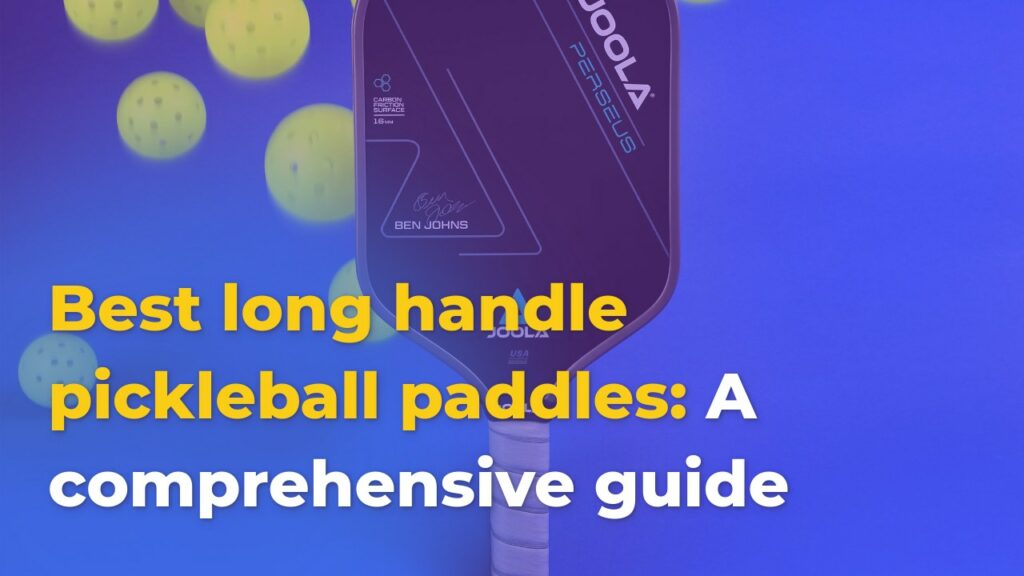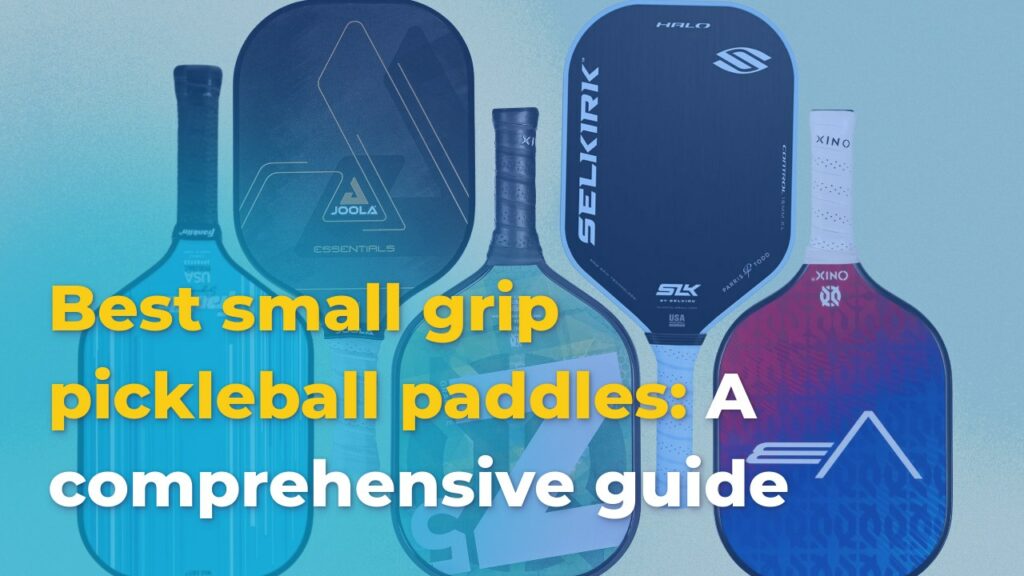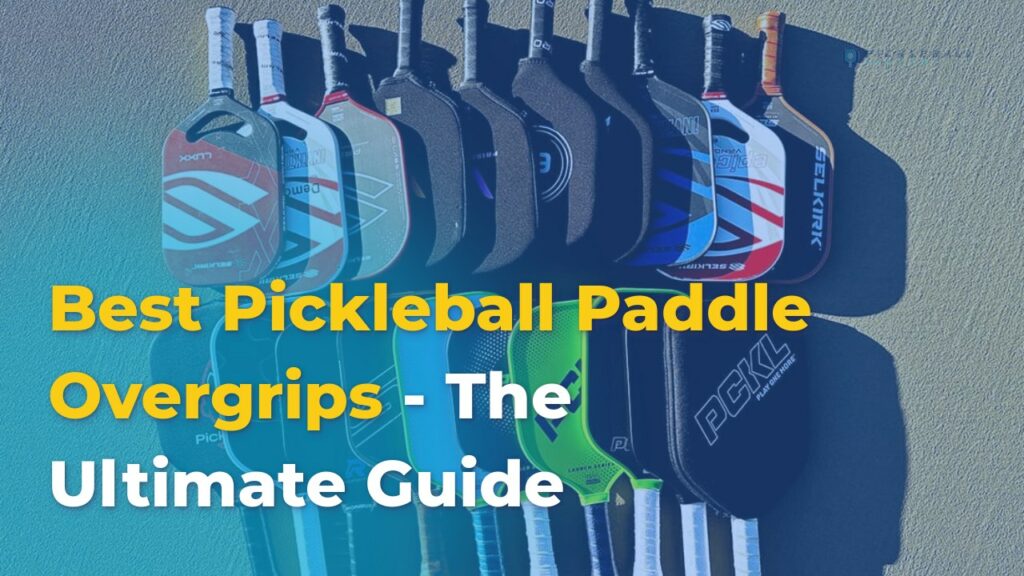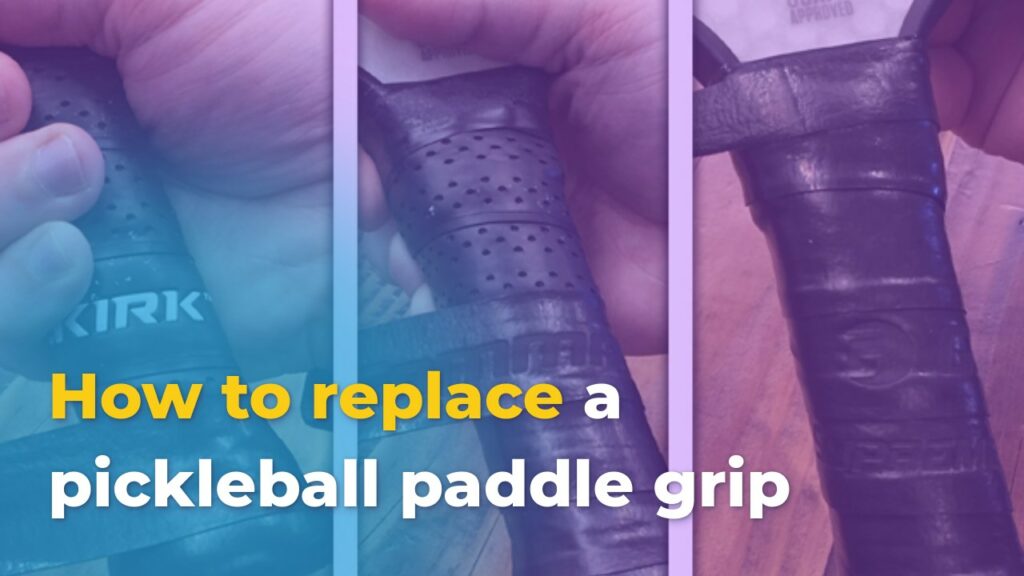Choosing the right pickleball paddle can dramatically improve your game. From power and control to comfort and feel, the right paddle can make a significant difference on the court. This guide will walk you through the key factors to consider when selecting your perfect match.
While it might seem overwhelming with so many paddle options available, understanding the essential elements and how they relate to your individual needs and playing style will make the selection process easier and more rewarding.
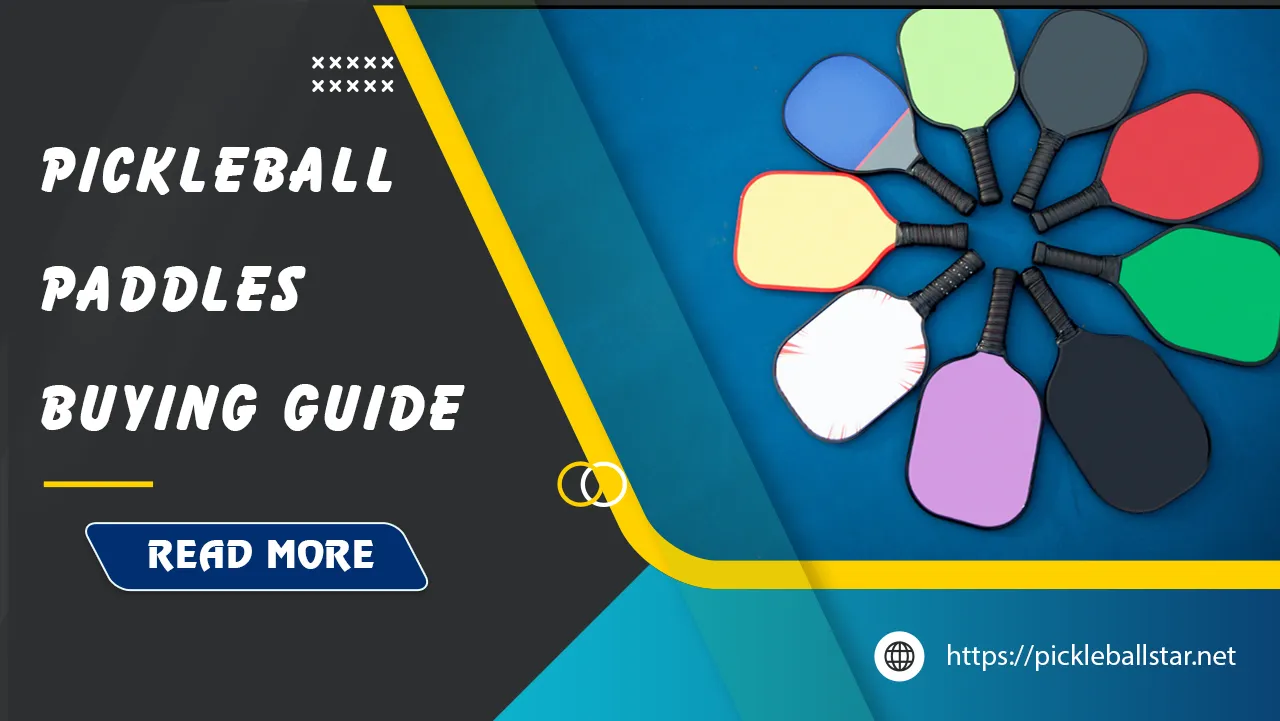
Matching the Paddle to the Player
Skill Level
Choosing the right pickleball paddle is crucial for improving your game and overall enjoyment of the sport. Your skill level should be a key factor in selecting the appropriate paddle.
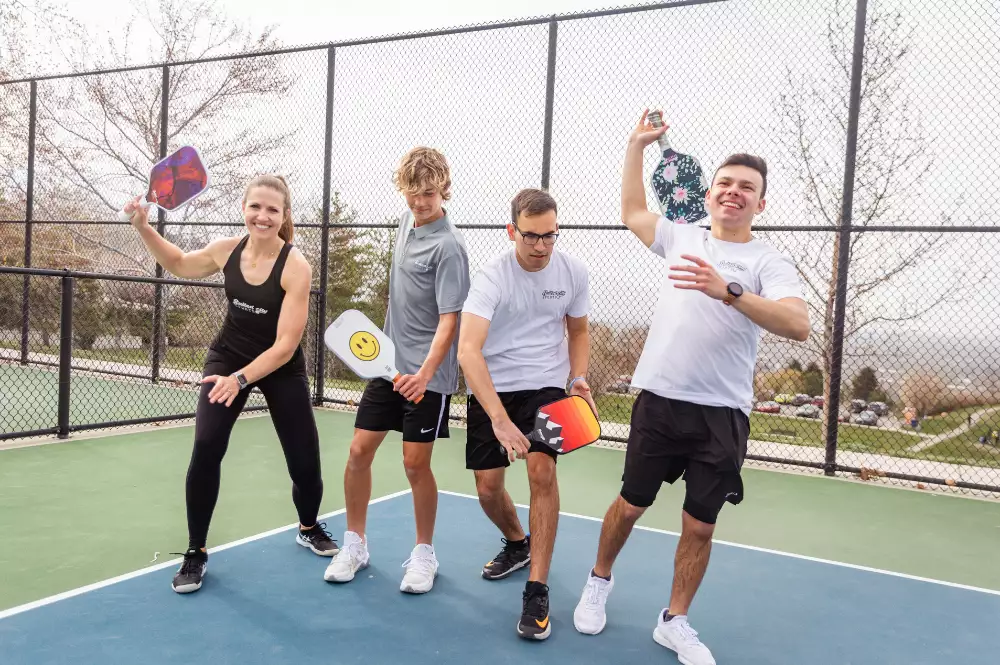
Beginner Players: Beginner players, including youth players, will benefit from a paddle with a larger hitting surface and a lighter weight. This provides more forgiveness and easier control as they are learning the game. Recommended paddle features for beginners include:
- Larger sweet spot and hitting surface area
- Lightweight, around 6-8 oz, to allow for easier maneuverability
- Standard or widebody paddle shape for more stability and power
- Wooden or composite materials, which are more affordable options
Readmore: Top 5 Best Pickleball Paddles For Beginners
Intermediate Players: As players progress, they can move to paddles that offer more power and control. Intermediate players typically benefit from:
- Composite paddles, which provide a balance of power and control
- Middleweight paddles in the 8-10 oz range, allowing for more power without sacrificing maneuverability
- Standard or elongated paddle shapes, depending on their preferred playing style
Advanced/Professional Players: Elite players often prefer paddles tailored for maximum performance. Key considerations for advanced players include:
- Graphite or high-end composite paddles for enhanced responsiveness, spin, and power
- Heavier paddles in the 10-14 oz range to generate more power and stability
- Elongated or widebody paddle shapes for increased reach and spin
- Attention to grip size, length, and material for optimal comfort and control
Regardless of skill level, it is important to test out different paddle options to find the one that best suits your playing style, physical attributes, and personal preferences.
Read more: Top 8 Best Pickleball Paddles for All Levels of Players
Physical Attributes
When choosing a pickleball paddle, it is important to match the paddle to the player’s physical attributes. The key factors to consider are:

- Skill Level: Beginners may prefer a more forgiving paddle that offers control, while advanced players may seek a paddle with more power and precision.
- Strength and Reach: The paddle should feel like an extension of the player’s arm. Factors like the player’s strength and arm reach should guide the paddle weight and size selection. Lighter paddles are easier to maneuver, while heavier paddles provide more power.
- Hand Size: The paddle grip size should fit the player’s hand comfortably. Grip size typically ranges from 4 to 5 inches in circumference, with 5 inches being standard. Players using a two-handed backhand may prefer a longer grip length of 5.25 inches or more.
- Playing Style: Aggressive net players may prefer stiffer paddles for power, while finesse players may opt for softer paddles that offer more control.
By considering these physical attributes, players can select a pickleball paddle that complements their strengths and playing style, leading to improved performance and enjoyment of the game.
Playing Style
When choosing a pickleball paddle, it is important to match the paddle to your playing style and preferences. Choosing the right pickleball paddle is akin to selecting the perfect tool for any craft it can make all the difference in your performance and enjoyment of the game.
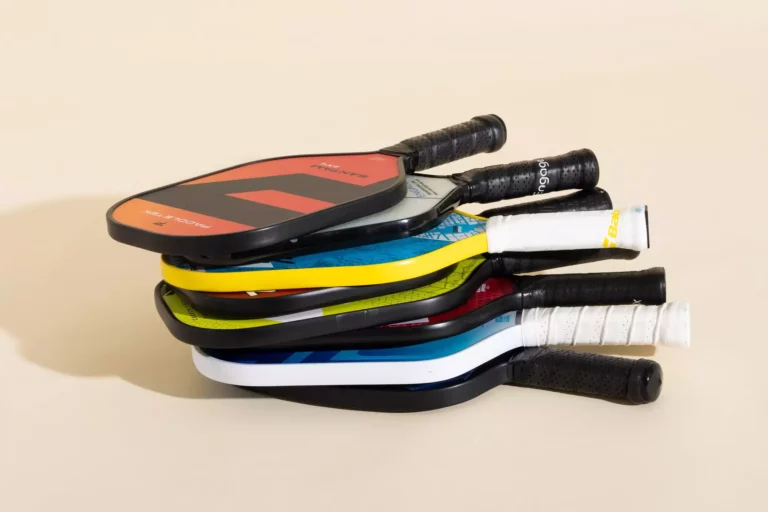
The original pickleball paddle was made from wood, but paddles have since transformed into composite materials to lessen weight and improve paddle performance. Wooden paddles are still commonly used in many schools and local clubs as inexpensive options to bring new players into the game, but most people that get into the sport eventually graduate to a lighter and better performing composite pickleball paddle.
- Power Players: Power players need paddles that provide extra weight and stiffness for generating strong shots. Opt for paddles heavier than 8 oz with fiberglass or carbon fiber surfaces.
- Control Players: Players who focus on precision and placement need lightweight paddles with a large sweet spot. Look for paddles weighing under 7.3 oz with polymer cores and textured grips.
- All-Around Players: Midweight paddles are perfect for players who balance power and control. These paddles typically weigh between 7.3 to 8.4 oz and have composite cores, offering a versatile range of options suitable for various playing styles.
Read more: Top 8 Best Pickleball Paddles For Control
Professional player Ben Johns recommends setting up your paddle with a 16mm thick core, Jigsaw Health paddle overgrips, and YONEX Super GRAP racket grips. He also suggests adding lead tape for extra weight and control.
For senior players, warming up properly is critical in preparing the body for a game of pickleball. The mental stimulation of the game can also help seniors maintain cognitive sharpness.
Read more: Top 5 Best Pickleball Paddles For Spin
Breaking Down the Features of a Pickleball Paddle
When choosing a pickleball paddle, there are several key factors to consider:
- Weight: Affects power, control, and comfort. Lighter paddles (under 7.3 oz) offer more control, while heavier paddles (over 8.5 oz) provide more power.
- Grip and Handle Length: Should fit your hand comfortably, with most paddles having 4-5 inch handles. Shorter handles are better for players transitioning from ping pong, while longer handles may suit tennis players.
- Paddle Thickness: Impacts feel and power, with thinner paddles (under 16mm) offering more power but less control, and thicker paddles (over 16mm) providing more control and potential for spin.
- Paddle Shape: Such as squared, rounded, or elongated, affects the size of the sweet spot and the paddle’s overall playability. Rounded shapes have smaller sweet spots but can enhance spin, while elongated shapes increase reach.
- Paddle Core Material: Such as Nomex, aluminum, or polypropylene, influences feel, power, and cushioning upon impact.
- Grip Size: Needs to fit comfortably in your hand. Grip lengths typically range from 4 1/4 to 6 1/4 inches, with around 5 inches being standard. If you plan to use a two-handed backhand, opt for a longer grip length.
By considering these key factors, you can find the pickleball paddle that best suits your playing style, skill level, and personal preferences.
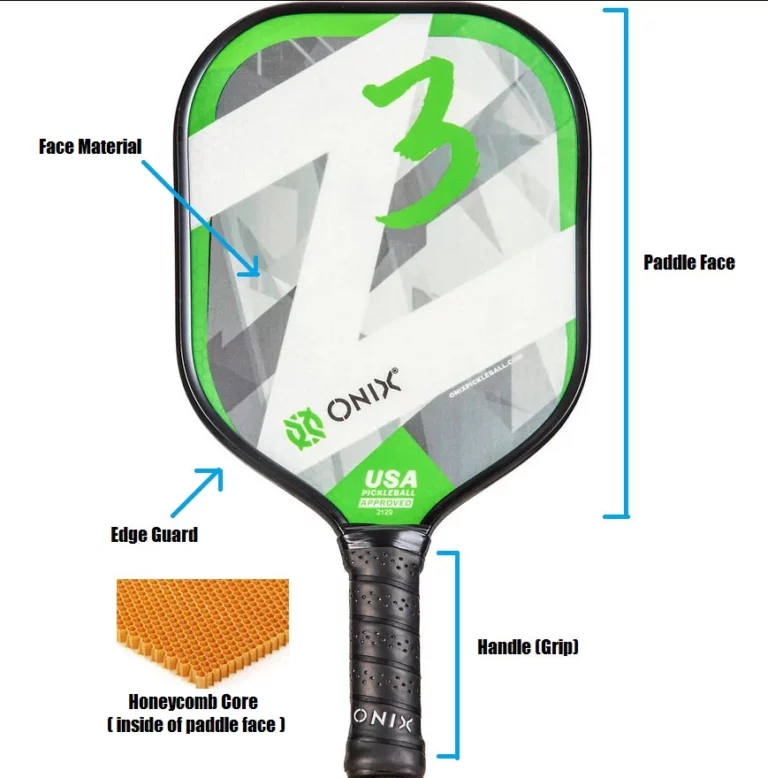
Face
The face of a pickleball paddle is an important consideration when selecting the right paddle. The paddle face can be made from a variety of materials, each with its own unique characteristics:
- Polymer Paddles: Lightweight and durable, offering a good mix of power and control, making them a popular choice for beginners.
- Graphite Paddles: Lightweight and provide excellent response, touch, and control, though they may not offer as much power as other materials.
- Composite Paddles: Made from a blend of materials like carbon fiber and fiberglass, often the heaviest but can deliver impressive power.
- Wooden Paddles: Classic feel and can provide good control, but lack the responsiveness and power of modern composite materials
- Edgeless Paddles: Remove the guard around the rim, increasing the hitting surface area, but can sacrifice some durability.
Core
The core material of a pickleball paddle is an important factor to consider when selecting a paddle. There are several common core materials used in pickleball paddles:
- Composite: Made from a combination of materials like graphite, aluminum, and fiberglass. They offer a good balance of power and control and typically have a larger sweet spot than wood paddles.
- Graphite/Carbon Fiber: Provide excellent power, control, and touch. They are often more expensive than other options but are popular among advanced players.
- Wood: These paddles are usually made from maple, birch, or basswood. They tend to be lighter and more maneuverable than composite paddles but have a smaller sweet spot, making them better suited for experienced players.
Grip
The grip is a crucial aspect of a pickleball paddle, as it provides the connection between the player and the paddle. When evaluating grip features, there are several key factors to consider:
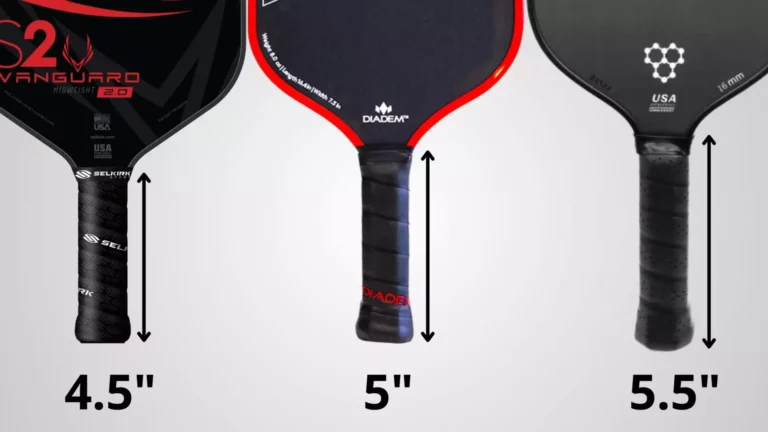
- Grip Size: The grip size should feel comfortable and secure in your hand. Typical grip sizes range from 4-5 inches, with 4.25-4.5 inches being a common standard. Shorter grips may be better for players with smaller hands, while longer grips can accommodate two-handed shots.
- Grip Material: The grip material can impact comfort and control. Common materials include perforated rubber, synthetic leather, and textured surfaces. Perforated grips help with sweat absorption and maintain a secure hold, while textured grips provide extra traction.
- Grip Thickness: The thickness of the grip can affect the overall feel and control of the paddle. Thinner grips are often preferred for players seeking more maneuverability, while thicker grips provide a more substantial and secure feel.
- Grip Comfort: The comfort of the grip is essential, as it can impact your ability to play for extended periods without fatigue or discomfort. Look for grips that offer cushioning and shock absorption to reduce strain on your hands and wrists.
- Grip Stability: A stable grip is crucial for maintaining control during shots. Features like anti-slip ridges, perforations, and moisture-wicking materials can help prevent the paddle from slipping in your hand.
When choosing a pickleball paddle, it’s important to consider your personal preferences and playing style. The right grip can make a significant difference in your overall performance and comfort on the court. By evaluating these grip features, you can find a paddle that provides the perfect balance of control, power, and comfort to elevate your pickleball game.
Weight
The weight of a pickleball paddle is a crucial factor to consider when choosing the right one. Pickleball paddles can be divided into three weight categories: lightweight (7.2 oz and under), midweight (7.3-8.4 oz), and heavyweight (8.4 oz and over).
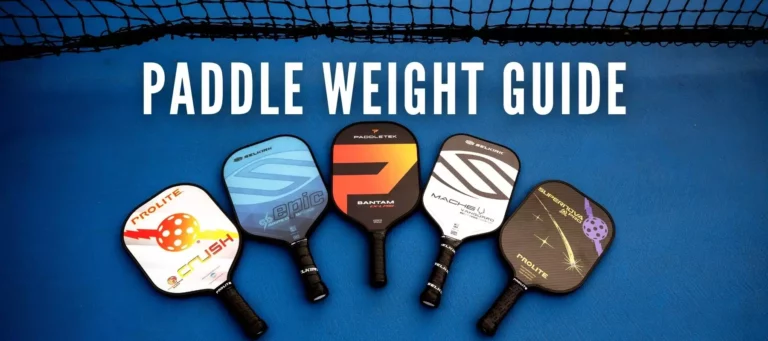
Lightweight Paddles:
- Offer maximum maneuverability and quick reactions, making them great for dink exchanges at the kitchen line.
- May lack power.
Midweight Paddles:
- Offer a balance of power and control, making them suitable for intermediate players.
Heavyweight Paddles:
- Designed to generate more force and power.
- Can sacrifice maneuverability and control.
It’s important to note that the weight of a paddle is not the only factor that determines its feel and performance. The distribution of the weight, or the paddle’s “swingweight,” is also crucial. Two paddles with the same static weight can feel very different when swung due to differences in their swingweight.
Swingweight
Paddle swingweight is determined by how the weight is distributed throughout the paddle. More weight in the head of the paddle will result in a heavier swingweight, while more weight in the grip will feel lighter and more maneuverable.
When choosing a pickleball paddle, it’s essential to consider not just the static weight but also the swingweight, as the swingweight will have a more significant impact on how the paddle feels and performs during play.
In addition to weight, other important features to consider include:
- Grip Size: The grip size should fit comfortably in your hand, with a range of 4 to 5 inches in circumference being the most common.
- Paddle Shape: Paddles come in three main shapes: standard, hybrid, and elongated. Standard and hybrid paddles are generally more forgiving for beginners, while elongated paddles offer more reach and power for advanced players.
- Paddle Material: Paddles can be made from various materials, such as graphite, composite, or wood, each with its unique characteristics regarding power, control, and spin.
When choosing a pickleball paddle, consider your skill level, playing style, and personal preferences to find one that best suits your needs. Trying different paddles through demo programs or borrowing from friends can be a great way to find the perfect fit.
Key Paddle Features to Consider
Power vs. Control
The main differences between power and control pickleball paddles lie in the paddle’s core, weight, shape, and surface material.
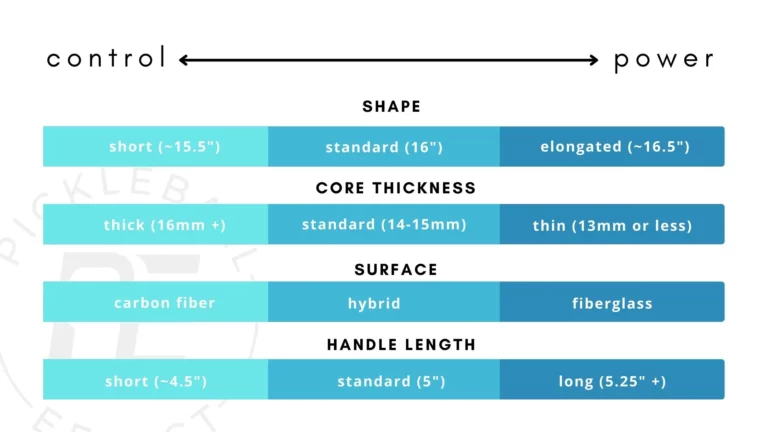
Power Paddles:
- Core: Thinner core, around 13-15 mm thick, to maximize the “trampoline effect” and provide more power and ball speed.
- Weight: Heavier, around 8 oz or more, to generate more force and power.
- Shape: Longer and narrower shape to increase the power of shots.
- Surface: Fiberglass or carbon fiber surface materials that are stiffer to provide more power and “pop.”
Control Paddles:
- Core: Thicker core, around 16 mm or more, to absorb more of the ball’s energy and facilitate precise shots.
- Weight: Lighter, around 7.3 oz or less, for better control and maneuverability.
- Shape: Shorter and wider with a larger sweet spot for improved control.
- Surface: Graphite or composite materials that are more forgiving and allow for better control.
Hybrid Paddles:
- Offer a balance of power and control, with a face stiffness around 900 lb/in.
- Can be a good compromise for intermediate players developing their skills.
When choosing a pickleball paddle, consider your playing style, skill level, and preferences for power vs. control. Power paddles are better for skilled players who rely on power, while control paddles are more suitable for players focused on precision and placement. Hybrid paddles can be a good all-around option.
Sweet Spot Size
The size and position of the sweet spot can vary significantly across different paddle designs, materials, and weights, influencing how a paddle performs. Paddles with larger sweet spots offer more forgiveness and margin for error, allowing players to hit the ball accurately even if they don’t strike the exact center of the paddle.
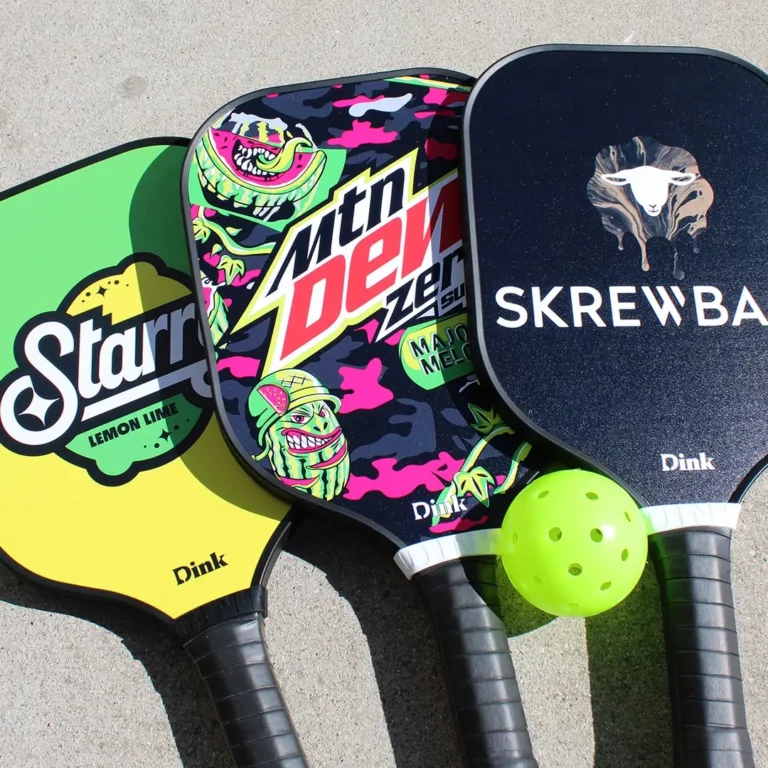
Key features to consider for a paddle with a large sweet spot include:
- Paddle Shape and Size: Standard-shaped paddles between 16-16.5″ long and 7.5-8″ wide tend to have the most universal sweet spots.
- Face Material: Paddles with carbon fiber, graphite, or composite faces often have larger and more consistent sweet spots.
- Core Material: Paddles with soft, responsive cores like honeycomb or polymer tend to have larger sweet spots.
- Edgeless Design: Paddles without edge guards can expand the sweet spot to the edges of the paddle face.
When choosing a pickleball paddle, assessing the sweet spot size and location is crucial, as it directly impacts shot accuracy and control. Paddles with larger, more forgiving sweet spots are ideal for beginner to intermediate players, while advanced players may prefer a smaller, more precise sweet spot.
Edge Guard Design
Edge guard design is an essential feature in pickleball paddles as it impacts both durability and playability.
Key Considerations for Edge Guard Design:
- Materials: Typically made from durable materials like rubber, silicone, or other synthetic materials.
- Impact on Weight Distribution: The thickness and design of the edge guard can affect the paddle’s weight distribution and aerodynamics.
- Surface Texture: Textured edge guard surfaces can enhance spin capabilities and ball control.
When choosing a pickleball paddle, understanding your playing style and the specific features of the edge guard can help you find a paddle that offers durability without compromising performance.
Advanced Details & Customizations
Paddle Shape
Paddle shape is a critical factor when choosing a pickleball paddle, as different shapes cater to different play styles. There are several advanced paddle shapes to consider:

- Elongated Paddle Shape: Offers extra reach and leverage, making it ideal for aggressive players who prefer to attack, speed up balls, and hit powerful drives. The elongated design makes it the “weapon of choice for the assertive player.”
- Wide-Body Paddle Shape: Provides a more forgiving sweet spot and is better suited for players focused on finesse, drops, resets, counters, and carefully placed shots. The broader paddle face offers more control for precise shot-making.
- S2 Shape: Prioritizes the largest possible sweet spot, though it has a shorter handle length to accommodate the taller paddle face. It’s beneficial for players with a “finger up” grip or a table tennis background.
- Epic Shape: A balanced option, providing a generous sweet spot with a standard handle length. It’s a solid choice for new or intermediate players seeking consistent performance and a good mix of control and power.
- Invikta Shape: For players ready to sacrifice some sweet spot for extra reach, the Invikta’s elongated face and standard handle suits intermediate to advanced players, including tennis converts.
- Max Shape: Similar to the Epic, the Max offers a traditional shape with a generous sweet spot, making it suitable for players not yet ready for elongated paddles but wanting a reliable, consistent paddle.
- XL Shape: Designed for intermediate to advanced players willing to trade-off a narrower sweet spot for added reach. It provides a familiar feel for tennis players with its elongated face.
Read more: Top 6 Best Pickleball Paddle For Women
Edge Guard Variations
Edge guard variation is another area where advanced players can make nuanced decisions to suit their play style better.
| Edge Guard | Pros | Cons |
| Traditional | Extra durability and protection | Slightly reduces hitting area |
| Edgeless | Larger hitting area | Slightly less durable |
Offstage Guarding: Jump offstage and interrupt the opponent midair, leaving the edge guarder vulnerable but potentially delivering a KO. Ideal forbet Edge Guard Variations characters with multiple jumps, such as Jigglypuff, Kirby, and Meta Knight. In pickleball, however, your focus will be on maintaining balanced edge guard design that supports your play style without compromising durability and performance.
Onstage Guarding: Using powerful attacks like forward smashes or towering smashes to control the game at the baseline. In pickleball terms, this approach might translate to maintaining a consistent rally using a paddle with a moderate edge guard that doesn’t sacrifice too much in terms of paddle responsiveness.
Projectile Guarding: Characters with projectiles like Pikachu or Samus use these long-range attacks to force an opponent into unfavorable positions. In pickleball, an edge guard that includes a textured surface or enhanced spin capabilities can replicate this effect, allowing players to strategically place shots that are difficult for opponents to return.
By considering how these variations in edge guard design impact your overall strategy, you can choose the right modifications to suit your playing style.
Surface Texture
Surface texture is a nuanced topic that encompasses several key characteristics, all contributing to how the paddle feels and performs during play.
- Lay: The predominant direction of the surface features, determined by the paddle’s construction process. Options include parallel, perpendicular, circular, crosshatched, radial, multi-directional, or isotropic (non-directional) textures.
- Roughness: Fine, short-wavelength irregularities on the paddle’s surface impacting friction and wear. Quantified using parameters like Ra (average roughness) and Rz (average peak-to-valley height).
- Waviness: Long-wavelength surface variations caused by manufacturing processes, measured using parameters like Wa (average waviness) and Wt (total waviness height).
Analyzing Surface Texture:
- Fitting: Removing the underlying form or tilt to focus on finer details.
- Filtering: Separating roughness and waviness components by applying a Gaussian filter with appropriate cutoff wavelengths. Cutoff values are crucial as they determine what is considered roughness versus waviness.
- Analysis: Visually exploring the surface profiles and quantifying characteristics using various roughness and waviness parameters. Advanced techniques may involve 3D profiling for a detailed view.
Paddles with different surface textures can significantly influence your playing experience by affecting how the ball interacts with the paddle. For instance, a rougher texture might provide better grip for spin shots, whereas a smoother texture may offer a cleaner strike for power shots.
Testing Before You Buy
Before making a purchase, it’s highly advisable to test out different pickleball paddles. This hands-on approach allows you to get an authentic feel for various weights, grips, and materials. Here are some practical methods for testing paddles:
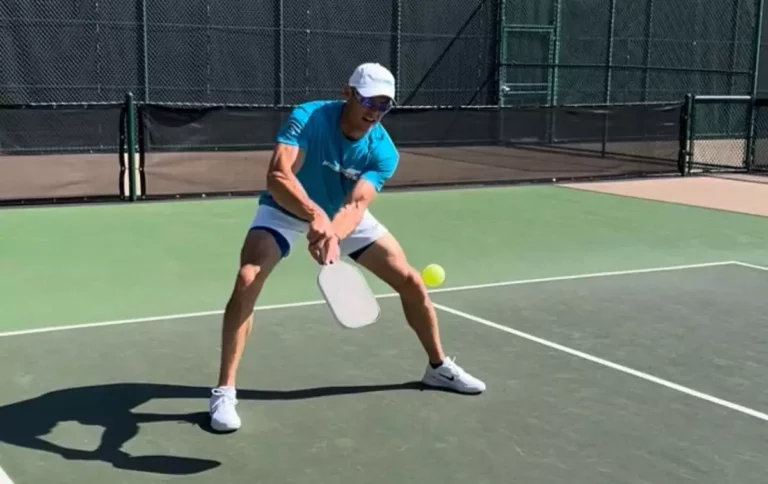
- Demo Days: Many pickleball clubs and retailers host demo days, where you can try a range of paddles under real playing conditions. These events are excellent for understanding how different paddles perform in various scenarios.
- Borrowing: If demo days aren’t an option, borrowing paddles from friends or fellow club members can be a practical solution. This provides an informal yet insightful way to test multiple paddles.
- Retailer Policies: Some retailers offer “try before you buy” programs, allowing you to test a paddle for a short period before committing to a purchase. Be sure to check the return policy if it turns out not to be the perfect fit for you.
By thoroughly testing before buying, you’ll be better equipped to select a paddle that truly complements your playing style, skill level, and physical attributes.
Debunking Paddle Myths
There are several myths surrounding pickleball paddles that can mislead players into making ill-informed decisions. Let’s debunk some common misconceptions.
Myth #1: Heavier Paddles are Always Better for Power
While it’s true that heavier paddles can generate more power due to increased mass, this isn’t a universal rule. Heavier paddles can also lead to fatigue and decreased maneuverability. Therefore, balance is key a paddle that’s too heavy can hinder your game as much as one that’s too light.
Fact: Power comes from the combination of weight, swing technique, and the paddle’s core and surface material. Skilled players may opt for a balanced-weight paddle to maintain both control and power.
Myth #2: Composite Paddles are Superior to All Other Materials
Composite materials like carbon fiber and fiberglass are indeed excellent for advanced paddles, but they aren’t the be-all and end-all. Beginners, for instance, may find wooden or polymer paddles more forgiving and easier to handle.
Fact: The best material depends on your skill level, playing style, and specific needs. Each material whether wood, composite, graphite, or aluminum has its pros and cons that should be carefully evaluated before making a decision.
Myth #3: All Expensive Paddles are Automatically Better
Price isn’t always an indicator of superior performance. While high-end paddles often incorporate advanced technology and materials, many mid-range paddles offer excellent quality and performance for a fraction of the cost.
Fact: Evaluate a paddle based on its features, weight, core, surface material, and how it complements your playing style, rather than just its price tag. Sometimes, the most suitable paddle falls within a more affordable price range.
Read more: Top 6 Best pickleball paddles under $100
Paddle Maintenance & Care
Taking good care of your pickleball paddle is crucial to maintaining its performance and longevity. Here are some tips on paddle maintenance:
Cleaning
- Regular Cleaning: Wipe the paddle face with a damp cloth after each playing session to remove dirt and sweat.
- Deep Cleaning: Occasionally, use mild soap and water for a thorough clean, especially if the paddle has accumulated grime. Avoid harsh chemicals that can damage the paddle surface and core.
Read more: How to clean Pickleball Paddle
Storage
- Avoid Extreme Temperatures: Exposure to excessive heat or cold can warp the paddle and degrade its materials. Store your paddle in a cool, dry place when not in use.
- Protective Covers: Use a paddle cover to prevent scratches and other potential damage. These covers provide an extra layer of protection when storing or transporting your paddle.
Handling
- Avoid Throwing or Dropping: Even the sturdiest paddles can suffer from hard impacts. Handle your paddle carefully to prolong its lifespan.
- Regular Inspections: Check for any signs of damage, such as cracks, chips, or loose edge guards. Catching issues early can prevent more severe damage and extend the paddle’s usability.
Read more: How long do pickleball paddles last?
Budget-Friendly Paddle Tips for Beginners
For beginners, cost is often a significant consideration when purchasing a pickleball paddle. Fortunately, there are quality options available that won’t break the bank.
Affordable Materials
- Wooden Paddles: Typically priced between $15-$30, wooden paddles provide a cost-effective starting point. While they might not offer the advanced features of composite or graphite paddles, they are durable and provide a solid foundation for beginners.
- Polymer Paddles: Priced in the $30-$60 range, these paddles offer a good balance of cost and performance. They are lighter and more responsive than wood but still affordable.
Entry-Level Models
- Paddletek Bantam TS-5: Around $50-$70, this paddle offers a good blend of power and control, making it an excellent choice for beginners moving up.
- Onix Z5 Graphite: Priced between $60-$90, this model is popular for its lightweight design and excellent touch, ideal for new players.
Buying Guides
- Second-Hand Paddles: Websites like eBay or local community groups often have gently used paddles for sale at reduced prices. Ensure the paddle is in good condition and free from any major damage.
- Beginner Sets: Several manufacturers offer complete sets that include paddles, balls, and carrying cases. These sets usually cost $40-$100 and provide everything needed to start playing immediately.
Upgrading Your Paddle
As you gain experience and improve your skills, you might find it beneficial to upgrade your paddle. Upgrading provides an opportunity to tailor your equipment more closely to your playing style and performance goals.
When to Upgrade
Signs it might be time to upgrade your paddle include:
- Performance Plateaus: If you’ve hit a performance plateau and feel your current paddle is holding you back, it might be time for an upgrade.
- Wear and Tear: Significant signs of wear, such as cracks, chips, or an unresponsive feel, indicate it’s time to invest in a new paddle.
- New Playing Style: As your playing style evolves, you may need a paddle that offers different characteristics, such as more power or control.
Features to Look For
When upgrading, consider features that align with your advanced needs:
- High-End Materials: Graphite, carbon fiber, and advanced composites provide enhanced performance.
- Customized Grip: Look for grips with adjustable sizes and materials that offer better comfort and control.
- Advanced Cores: High-quality cores, such as Nomex or hybrid cores, can offer better response and durability.
Recommended Upgraded Paddles
| Paddle Name | Core Material | Face Material | Price Range |
| Selkirk AMPED Invikta | X5 Polypropylene | Fiberglass | $130-$180 |
| Engage Poach Advantage | Polymer Honeycomb | Textured Composite | $130-$150 |
| Paddletek Tempest Wave Pro | Textured Composite | Textured Graphite | $130-$170 |
FAQs
Do All Pickleball Paddles Have the Same Shape?
No, pickleball paddles come in various shapes, such as elongated, wide-body, and traditional, catering to different playing styles and needs. The shape can impact the sweet spot, reach, and overall playability of the paddle.
What is the “Sweet Spot” of a Pickleball Paddle?
The sweet spot is the area on the paddle face where the ball makes optimal contact, providing the best balance of power and control. Larger sweet spots offer more forgiveness and are ideal for beginners, whereas smaller, more precise sweet spots may be preferred by advanced players.
What Are Some Reputable Pickleball Paddle Brands to Consider?
Reputable brands known for their high-quality pickleball paddles include:
Selkirk Sport: Known for their advanced technologies and high-performance paddles. Paddletek: Popular for a wide range of paddles that cater to different skill levels. Engage Pickleball: Offers paddles with great balance and playability. Onix: Known for durable, high-quality paddles suitable for all levels of play. Gamma: Offers innovative and well-engineered paddles.
How Do Pickleball Paddles Compare to Tennis Rackets in Terms of Weight and Size?
Pickleball paddles are smaller and lighter than tennis rackets. They typically weigh between 6-14 oz and have a surface area of around 85-90 square inches. In contrast, tennis rackets can weigh around 8-13 oz and have a string area of approximately 95-100 square inches. The reduced weight and size of pickleball paddles offer greater maneuverability and control, catering to the quick-paced nature of the sport.
Conclusion
Choosing the right pickleball paddle is an important step in enjoying the game to the fullest. By understanding the key factors like weight, grip, core material, and playing style, you can find the perfect paddle to enhance your performance, comfort, and overall experience on the court.
Take your time, research the options, and find the pickleball paddle that makes you excited to step onto the court and play your best game! Exploring different paddles will provide you with insights and perspectives that enhance your connection to the sport. Whether you’re a beginner looking to understand the basics, an intermediate player refining your skills, or an advanced player aiming for precision, taking the time to find the perfect paddle is an investment in your enjoyment and performance in pickleball.

